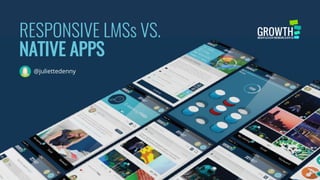
Responsive LMSs VS Native Apps
- 1. RESPONSIVE LMSs VS. NATIVE APPS @juliettedenny
- 2. Mobile is no longer the future of learning and development. It’s the now. And it has been ever since mobile usage surged ahead of desktop usage back in November 2016. According to Dscout research, people touch their phones 2,617 times a day (on average). Smartphones aren’t just a helpful tool, they’re part of the way we interact with the world. Ray Kurzweil explains that ‘Mobile phones are misnamed. They should be called gateways to human knowledge.’ THE IMPORTANCE OF MOBILE LEARNING
- 3. THE OPTIONS Whilst most learning and development professionals recognise a need to incorporate a mobile learning strategy within their wider training approach, there is still some debate regarding the best way to deliver this. There are two available options: • Mobile learning via a responsive website or LMS. • Mobile learning via a native app solution. Let’s take a look at both options.
- 4. WHAT IS A RESPONSIVE LMS? A responsive website or LMS is a site that adapts to any screen size. It should be easy to use, regardless of the device you choose to access it with. As such, it should look great on mobile, tablets and desktops alike. Unresponsive websites will usually look great and perform well on desktops, but create a variety of user experience issues on mobile devices. This can often result in a lot of horizontal scrolling and pinching. Ultimately, if the experience is frustrating enough, the user might well give up. That’s not something you want to happen during the course of your online learning roll-out.
- 5. WHAT IS A NATIVE APP? A native application is a software programme that has been developed for a particular platform. You access these apps via your phone by tapping on an icon on your home screen. Examples include, WhatsApp, Spotify, Tinder and Growth Engineering’s very own Knowledge Arcade. Mobile learning apps can be used to support, or even act as the bedrock of your training campaign. As mobile learning apps run on specific operating systems they’re able to make use of a smartphone’s built-in features. This means your learning app could use features like video, GPS or cameras.
- 6. WHAT ARE THE PROS OF A RESPONSIVE LMS? ADVANTAGES: • Less Expensive: Responsive websites are usually cheaper to produce, as you don’t have to create versions for every operating system. • Availability: A responsive website is available to everyone, regardless of their operating system. It doesn’t require downloading. • Updates: It’s easy to make changes to responsive websites, as the end users don’t need to install any updates or patches.
- 7. WHAT ARE THE CONS OF A RESPONSIVE LMS? DISADVANTAGES: • Less functionality: Responsive websites are limited in the way they access your smartphone’s inbuilt features. For instance, with a responsive website, you can’t utilise push notifications. • Internet Connection Required: Unlike some mobile app solutions, which will work whilst you are offline, responsive websites must be accessed via an active internet connection. • Off Trend: Smartphone usage is built around accessing apps – according to an eMarketer report, the average person spends 90% of their time in mobile apps vs the mobile web.
- 8. WHAT ARE THE PROS OF A NATIVE APP? ADVANTAGES: • Superior UX: Because native apps have a mobile first design, the user experience often improves on that offered by a responsive website. • Extra Functionality: Native apps have direct access to your smartphone’s inbuilt functionality. This enables you to unleash the power of push notifications! • Offline Access: You don’t need a live internet connection to access an app. In fact, many mobile learning apps offer online / offline sync capacity.
- 9. WHAT ARE THE CONS OF A NATIVE APP? DISADVANTAGES: • Manual Download Process: It’s easy to access a responsive website via your browser. To access an app, however, you need to locate it in the App Store and download it. These additional steps can damage the uptake of your learning programme. Likewise, updates need to be installed across all user devices, rather than automatically rolled-out. • Additional Cost: Because separate apps have to be developed and updated for every operating system, native apps can end up being expensive endeavours.
- 10. THE CONCLUSION Ultimately, the right solution for you depends on a variety of factors, including (but not limited to): your budget, your audience, your timescale and your overall learning goals. We hope that this slide deck empowers you to make an informed decision. Should you go down the native app route, you’ll need to consider whether your learners have the capacity and know-how they’ll need to download your app solution. If so, you should be well positioned to deliver masterful mobile learning experiences.
